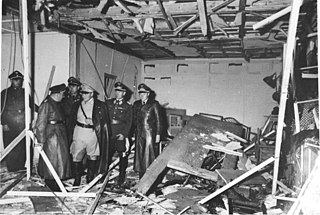
The Waffen-SS was the combat branch of the Nazi Party's paramilitary Schutzstaffel (SS) organisation. Its formations included men from Nazi Germany, along with volunteers and conscripts from both occupied and unoccupied lands. It was disbanded in May 1945.

Claus von Stauffenberg was a German army officer who is best known for his failed attempt on 20 July 1944 to assassinate Adolf Hitler at the Wolf's Lair.

The 20 July plot was a failed attempt to assassinate Adolf Hitler, the chancellor and leader of Nazi Germany, and subsequently overthrow the Nazi regime on 20 July 1944. The plotters were part of the German resistance, mainly composed of Wehrmacht officers. The leader of the conspiracy, Claus von Stauffenberg, planned to kill Hitler by detonating an explosive hidden in a briefcase. However, due to the location of the bomb at the time of detonation, the blast only dealt Hitler minor injuries. The planners' subsequent coup attempt also failed and resulted in a purge of the Wehrmacht.

Ernst Bernhard Wilhelm Busch was a German Generalfeldmarschall during World War II who commanded the 16th Army and Army Group Centre.

Job Wilhelm Georg Erdmann Erwin von Witzleben was a German Generalfeldmarschall in the Wehrmacht during the Second World War. A leading conspirator in the 20 July plot to assassinate Adolf Hitler, he was designated to become Commander-in-Chief of the Wehrmacht in a post-Nazi regime had the plot succeeded.

Operation Valkyrie was a German World War II emergency continuity of government operations plan issued to the Territorial Reserve Army of Germany to execute and implement in the event of a general breakdown in civil order of the nation. Failure of the government to maintain control of civil affairs might have been caused by the Allied bombing of German cities, or uprising of the millions of foreign forced labourers working in German factories.

Carl-Heinrich Rudolf Wilhelm von Stülpnagel was a German general in the Wehrmacht during World War II who was an army level commander. While serving as military commander of German-occupied France and as commander of the 17th Army in the Soviet Union during Operation Barbarossa. Stülpnagel participated in German war crimes, including authorising reprisal operations against civilian population and cooperating with the Einsatzgruppen in their mass murder of Jews. He was a member of the 20 July Plot to assassinate Adolf Hitler, being in charge of the conspirators' actions in France. After the failure of the plot, he was recalled to Berlin and attempted to commit suicide en route, but failed. Tried on 30 August 1944, he was convicted of treason and executed on the same day.

The SS Division Hitlerjugend or 12th SS Panzer Division "Hitlerjugend" was a German armoured division of the Waffen-SS during World War II. The majority of its junior enlisted men were drawn from members of the Hitler Youth, while the senior NCOs and officers were from other Waffen-SS divisions.

The 10th Panzer Division was an armoured division in the German Army, the Heer, during World War II, established in March 1939.

Caesar von Hofacker was a German Luftwaffe Lieutenant Colonel and member of the 20 July plot against Adolf Hitler.

The 4th Panzer Division was an armored division in the Army of Nazi Germany.

Otto Edwin von Stülpnagel was a German military commander of occupied France during the Second World War. Arrested by Allied authorities after the war, he committed suicide in prison in 1948.
The 7th Panzer Division was an armored formation of the German Army in World War II. It participated in the Battle of France, the invasion of the Soviet Union, the occupation of Vichy France, and on the Eastern Front until the end of the war. The 7th Panzer Division is also known by its nickname, Ghost Division.

Friedrich Olbricht was a German general during World War II. He is known for being one of the plotters involved in the 20 July Plot, an attempt to assassinate Adolf Hitler in 1944.

Gerhard Helmut Detleff Graf von Schwerin was a German General der Panzertruppe during World War II.

The 23rd Panzer Division was an armoured division in the German Army during World War II. Formed in France in late 1941, the division spent its entire combat history on the Eastern Front.
Hans Otfried von Linstow, was a German Army colonel. He took part in the 20 July Plot to assassinate Adolf Hitler.

Eberhard Finckh was a German colonel on the general staff of the German Army, a longtime opponent of Nazism and a member of the German resistance to Adolf Hitler's regime.

Hans von Boineburg-Lengsfeld was a German general in the Wehrmacht of Nazi Germany who commanded the 4th and 23rd Panzer Divisions during World War II. He was also a recipient of the Knight's Cross of the Iron Cross of Nazi Germany.
The 295th Infantry Division was an infantry division of the German Heer during World War II.
















